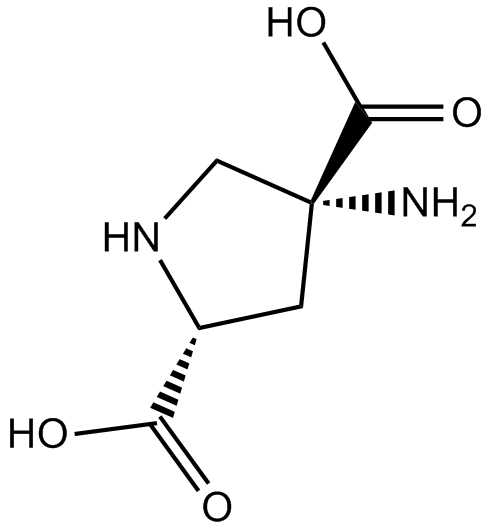(2R,4R)-APDC |
| Catalog No.GC11379 |
(2R,4R)-APDC est un agoniste sélectif des récepteurs métabotropiques du glutamate du groupe II (mGluR).
Products are for research use only. Not for human use. We do not sell to patients.

Cas No.: 169209-63-6
Sample solution is provided at 25 µL, 10mM.
EC50: 0.4 μM
2R,4R-APDC is a highly selective and relatively potent group II metabotropic glutamate receptor agonist for human mGlu2. L-Glutamate (Glu) is EAA neurotransmitter in the mammalian CNS. Its effects are mediated by a variety of presynaptic and postsynaptic neuronal receptors.
In vitro: 2R,4R-APDC blocked forskolin-stimulated cAMP with none of the other activities of lS,3R-ACPD. forskolin-stimulated cAMP formation in human mGluR2 expressing cells with about three-fold greater potency than lS,3R-ACPD were also inhibited by 2R,4R-APDC, which, unlike lS,3R-ACPD, exhibited no appreciable activation of phosphoinostide hydrolysis in human mGluR. Thus, 2R,4R-APDC should be a useful pharmacological tool to explore the functions of mGluRs coupled to inhibition of adenylate cyclase [1]. The effects of four isomers of APDC were investigated at glutamate receptors in vitro. (2R,4R)-APDC, an aza analog of the nonselective mGluR agonist (1S,3R)-ACPD possessed relatively high affinity for metabotropic glutamate receptors (mGluRs) with no effects on radioligand binding to NMDA, AMPA, or kainate receptors up to 100 íM. None of the other APDC isomers exhibited significant mGluR binding affinity, indicating that this interaction is highly stereospecific [2].
In vivo: Both (1S,3R)-ACPD and (2R,4R)-APDC were effectively attenuating forskolin-stimulated cAMP formation in the adult rat cerebral cortex; however, while (1S,3R)-ACPD was also effectively stimulating basal tritiated inositol monophosphate production of the neonatal rat cerebral cortex, (2R,4R)-APDC was not effectively stimulating phosphoinositide hydrolysis in this tissue preparation. An augmentation of AMPA-induced excitation was produced by microelectrophoretic application of either (1S,3R)-ACPD or (2R,4R)-APDC to intact rat spinal neurons [2].
Clinical trial: Clinical study has been conducted.
References:
[1] Schoepp DD, Johnson BG, Salhoff CR, Valli MJ, Desai MA, Burnett JP, Mayne NG, Monn JA. Selective inhibition of forskolin-stimulated cyclic AMP formation in rat hippocampus by a novel mGluR agonist, 2R,4R-4-aminopyrrolidine-2,4- dicarboxylate. Neuropharmacology. 1995 Aug;34(8):843-50.
[2] Monn JA, Valli MJ, Johnson BG, Salhoff CR, Wright RA, Howe T, Bond A, Lodge D, Spangle LA, Paschal JW, Campbell JB, Griffey K, Tizzano JP, Schoepp DD. Synthesis of the four isomers of 4-aminopyrrolidine-2,4-dicarboxylate: identification of a potent, highly selective, and systemically-active agonist for metabotropic glutamate receptors negatively coupled to adenylate cyclase. J Med Chem. 1996 Jul 19; 39 (15):2990-3000.
Average Rating: 5 (Based on Reviews and 31 reference(s) in Google Scholar.)
GLPBIO products are for RESEARCH USE ONLY. Please make sure your review or question is research based.
Required fields are marked with *




















